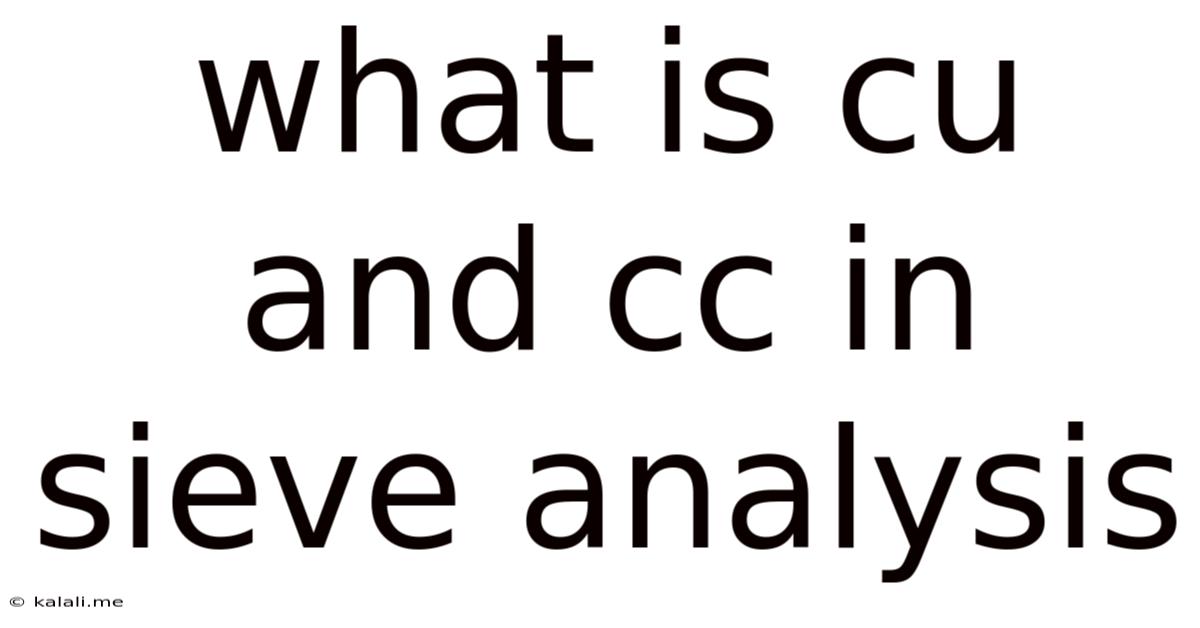What Is Cu And Cc In Sieve Analysis
Kalali
Jun 11, 2025 · 3 min read

Table of Contents
Understanding CU and CC in Sieve Analysis: A Comprehensive Guide
Meta Description: This guide explains the crucial concepts of coefficient of uniformity (CU) and coefficient of curvature (CC) in sieve analysis, essential for characterizing soil particle size distribution and its engineering properties. Learn how to calculate and interpret these vital parameters.
Sieve analysis is a fundamental technique in geotechnical engineering used to determine the grain-size distribution of granular materials like soil and aggregates. While the sieve sizes and the percentage retained on each sieve provide valuable data, two crucial parameters derived from this data offer a deeper understanding of the material's characteristics: the coefficient of uniformity (CU) and the coefficient of curvature (CC). These values provide insights into the uniformity and shape of the particle size distribution curve, ultimately influencing the material's engineering behavior.
What is the Coefficient of Uniformity (CU)?
The coefficient of uniformity (CU) is a dimensionless number that indicates the range of particle sizes present in a soil sample. It's calculated as the ratio of D<sub>60</sub> to D<sub>10</sub>, where:
- D<sub>60</sub> is the particle size (in millimeters) for which 60% of the soil sample is finer.
- D<sub>10</sub> is the particle size (in millimeters) for which 10% of the soil sample is finer.
A high CU value signifies a wide range of particle sizes, indicating a poorly graded or heterogeneous soil. Conversely, a low CU value suggests a narrow range of particle sizes, characteristic of a well-graded or homogeneous soil.
How to interpret CU values:
- CU < 4: Well-graded soil with a narrow particle size distribution.
- 4 ≤ CU ≤ 6: Moderately well-graded soil.
- CU > 6: Poorly graded or uniformly graded soil with a wide particle size distribution.
Understanding the CU is critical for determining a material's suitability for specific engineering applications. For instance, poorly graded soils might exhibit higher permeability and lower stability compared to well-graded soils.
What is the Coefficient of Curvature (CC)?
The coefficient of curvature (CC) provides information about the shape of the particle size distribution curve, specifically highlighting its curvature or skewness. It helps determine whether the soil has a gap-graded distribution or not. It is calculated as:
CC = (D<sub>30</sub>)² / (D<sub>10</sub> * D<sub>60</sub>)
where:
- D<sub>30</sub> is the particle size (in millimeters) for which 30% of the soil sample is finer.
The CC value indicates the distribution's shape:
- CC ≈ 1: Well-graded soil with a uniform distribution of particle sizes. This indicates an ideal gradation, with a proper mix of various sizes. The curve is relatively symmetrical.
- CC < 1: A gap-graded soil is indicated. This means there's a significant lack of particles within a certain size range. This can lead to a less stable soil structure.
- CC > 3: Poorly graded or uniformly graded soil; the curve is skewed. This suggests an uneven distribution with a concentration of particles in a specific size range.
The Combined Significance of CU and CC
Analyzing both CU and CC together provides a more comprehensive understanding of the soil's grain size distribution than either parameter alone. The combination allows for a better classification and prediction of the engineering properties of the soil. For example, a soil with a high CU and a CC value outside the ideal range (approximately 1) is likely to exhibit different behavior than a soil with a low CU and a CC close to 1.
Conclusion
The coefficient of uniformity (CU) and coefficient of curvature (CC) are indispensable parameters in sieve analysis. By understanding their calculation and interpretation, engineers can gain valuable insights into the characteristics of granular materials, ultimately leading to better design and construction practices. Accurate determination of these coefficients is crucial for various applications, ensuring the stability and performance of structures built upon or using these materials. Remember to always consult relevant geotechnical standards and guidelines for specific interpretations related to your project's requirements.
Latest Posts
Latest Posts
-
What Kind Of Room Has No Doors Or Windows
Jul 01, 2025
-
How Many Cups Of Elbow Macaroni Are In A Pound
Jul 01, 2025
-
How Many Guppies In A 5 Gallon Tank
Jul 01, 2025
-
How To Beat Stage 7 In Bloxorz
Jul 01, 2025
-
How Much Oz In A Bottle Of Water
Jul 01, 2025
Related Post
Thank you for visiting our website which covers about What Is Cu And Cc In Sieve Analysis . We hope the information provided has been useful to you. Feel free to contact us if you have any questions or need further assistance. See you next time and don't miss to bookmark.